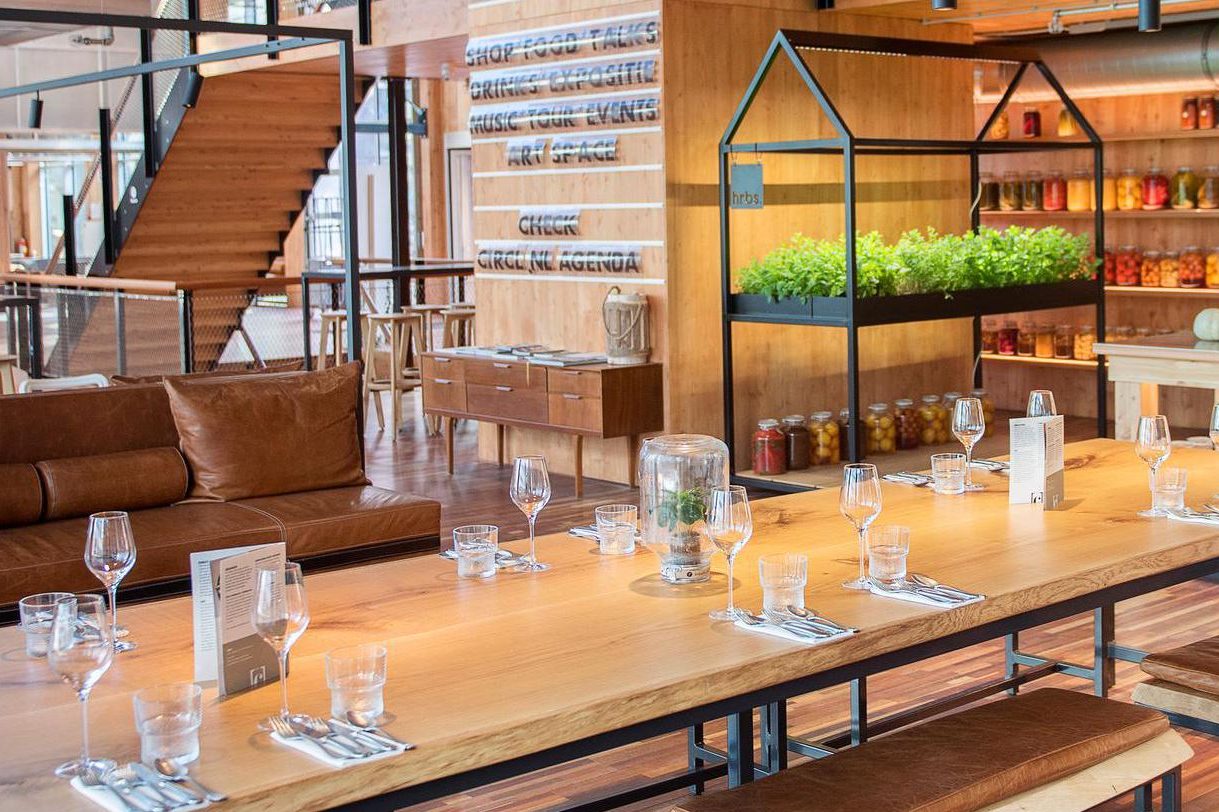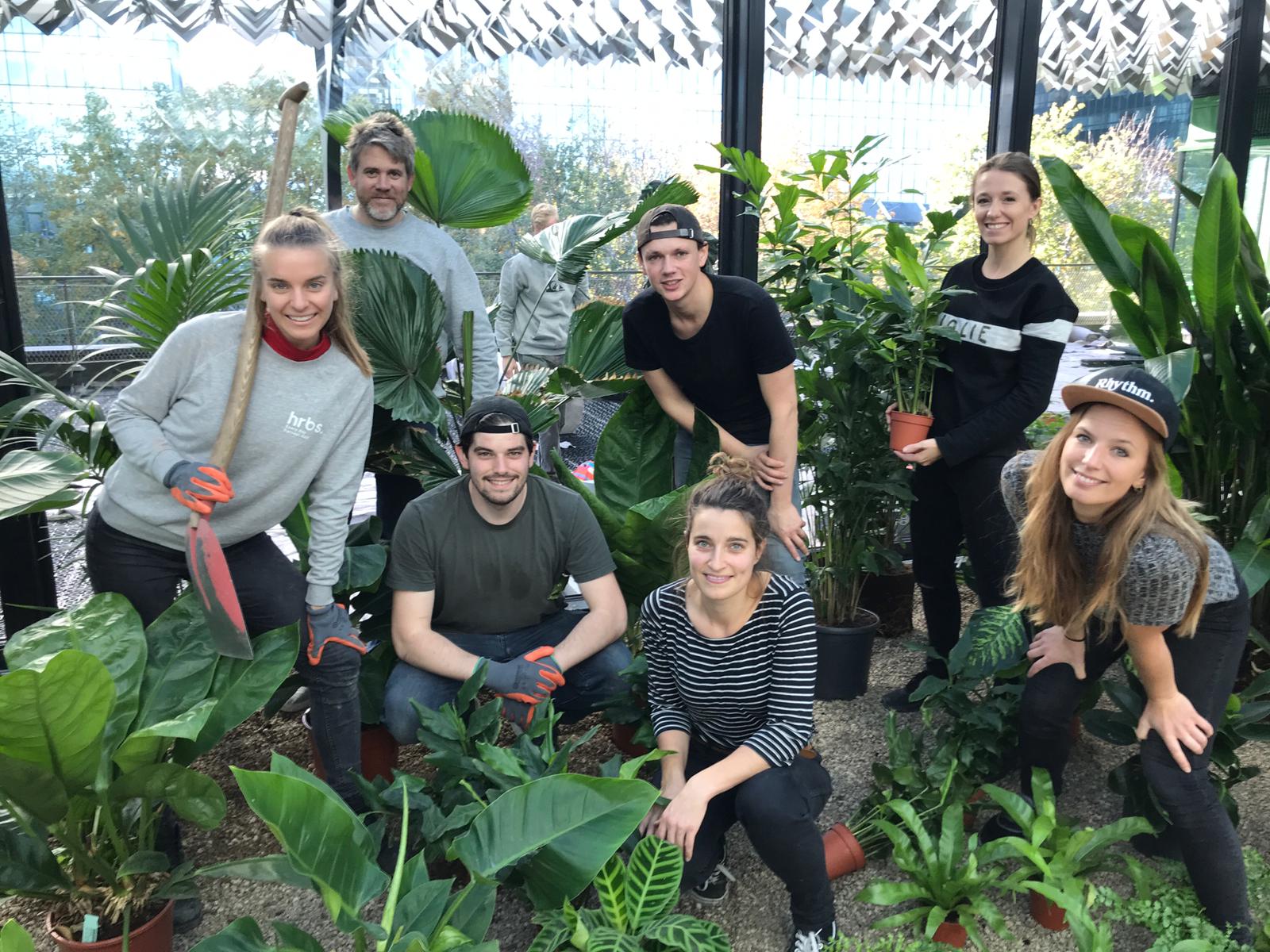Dec 18, 2018
Amsterdam Startup ‘Hrbs’ Pushes the Limit for Locally Grown Produce

Trays of living herbs and vegetables at The Green House Restaurant in Utrecht. The produce is routinely replenished by Amsterdam-based startup ‘Hrbs’. (Photo by Cepezed Architects)
by Scott Matus
What kitchen doesn’t want the freshest possible produce these days? After all, it looks better, tastes better, and has more nutritional value than the produce that has traveled for hundreds or often thousands of miles from its point of harvest.
Because of this increasing demand for the freshest possible local produce, urban farming models have been popping up around the world to bring the farm and harvest as close to the consumer as possible. In New York City alone these included Farm.One, who deliver hydroponically grown rare herbs via bicycle to restaurants around the city, and Smallhold, who grow mushrooms in custom designed containers located right inside restaurants and grocery stores.
One of the latest startups to capitalize on this demand for fresh-as-possible produce is Amsterdam-based Hrbs, who—as their name might imply—specialize is culinary herbs.
Unlike farms that deliver already harvested and washed produce, Hrbs is shaking the commercial urban farming model by delivering plants to restaurants, hotels and even private consumers who then, using an Hrbs designed system, continue to grow the plants right on location until the moment they’re ready to be used. The end result is plants that are not only as fresh as possible, but that also can function as an amenity showpiece adding green to a room, garden, or rooftop.

Hrbs-delivered plants growing in Hrbs designed furniture at ‘Circl Restaurant’ in Amsterdam.
At its core, Hrbs is an urban farming “service model where we bring ever-growing herbs and mini vegetables to people's kitchens in urbanized environments,” explains Hrbs Co-Founder Tessa Duste. “To put it simply, we take the hard part out of growing.”
Growing trays first get filled with crops at local partner nurseries, then they are transported only a short distance to the customer to continue growing until ready to harvest and eat. Once all the herbs have been consumed, the trays and substrate are then brought back to the nurseries to be upcycled for the next round of plants.
“Our primary goal is to reconnect people with their food, and to do so in as circular a system as we can,” says Tessa.

Members of the Hrbs team getting their hands in the soil to build indoor gardens at the new Nationale Postcode Loterij in Amsterdam.
Hrbs’ service is currently available throughout the entire Netherlands. They work with four nurseries to provide the plants, although plans are on the way to continue adding capacity. “Currently we have enough nurseries to supply us with the demand, but we will certainly need more as we expand,” Tessa says.
Customers have the option of purchasing trays with one type of herb, but their big hits are the Hrbs Combination Trays, includes Special‘Tea’ (Moroccan Mint, Lemon Balm, Swiss Mint and Thyme), Fresh Up Your Dish (Basil, Parsley, Chives and Cilantro), and their Seasonal Party Mix, which varies with each season. “Our Special‘Tea’ tea-leaf mix is probably our most popular tray,” says Hrbs Project Manager & Architect Kelai Diebel.
Customers also have a choice of ‘furniture’ that they purchase from Hrbs to house the trays of growing plants until the herbs are ready to be consumed. “We have a basic set of hardware solutions for customers,” Kelai explains, “and then we can also create custom solutions as well.”
All furniture options feature a water basin from which the trays’ capillary wicking system slowly drinks up water for the plants to access. Hrbs can also add LED lighting to the furniture for customers who vertically stack their systems or locate them away from natural sunlight.
For the time being, Hrbs operates as a business to business (B2B) model, supplying fresh produce to restaurants and hotels around the Netherlands, as well as a business to consumer (B2C) model, where any individual can order Hrbs online. “But we're also starting to look at offices who want to provide something extra to their employees,” says Tessa, “and we're interested in being a part of more urban farms”.
The Green House Restaurant in the center of Utrecht is one such urban farm/restaurant crossbreed that Hrbs is already a part of. The building itself is an architectural marvel, constructed out of a wide variety of reclaimed materials. An all-glass exterior provides excellent views of the second floor’s urban farm and private meeting rooms, which sit directly above the kitchen and 150-seat dining room that allows diners to peer up at the farm where their food was just harvested.
Hrbs first got involved at The Green House Restaurant through their client Albron, one of the Netherland’s largest food caterers, who wanted the restaurant to showcase the future of food. “Our major focus from the onset was making the farm space an integral part of the kitchen, so at the very beginning we worked closely with the chef to help tailor the farm to the needs of the menu,” explains Kelai.
The indoor farm now has over 600 Hrbs trays under the pink hue of LED lights, all of which get replenished with new herbs from the nursery at different rates. “Parsley we replenish every week,” Kelai explains, “but the ginger we replenish just once a season.”
In addition to Hrbs, many of the company’s employees also work for sister company MOSS, which stands for Makers of Sustainable Spaces.
“MOSS goes broader than just food,” Kelai explains, “it's all about designing living urban landscapes and bringing more green to more people.”
One of MOSS’s new projects in development is ALDIN Biodome, located in Reykjavik, Iceland. “The plan is to build a number of biodomes with tropical ecosystems inside that are heated by geothermal energy from the earth below,” says Kelai. “We're celebrating nature with circular systems where we consider the energy we use and the energy we give back.”
MOSS is also working on integrating big green statements into Booking.com’s headquarters in Amsterdam. “They're building a new campus and want it to be thriving with green,” says Tessa, “so we're working with other design teams to create a green flow throughout the entire 11 floors, and a 7,000 square meter living rooftop.”
For many projects, the services of Hrbs and MOSS complement each other.
Looking towards the future, “we want to go international with our Hrbs concept,” says Tessa. So far, Belgium and Iceland are two of their strongest contenders. “If we can make this service work here in the Netherlands, we believe that we can make it work for lots of other cities across the globe that have similar environmental conditions.”
“We would also like to optimize our concept to ‘close the loop’ even further,” Kelai says, “so maybe we could optimize our nurseries and have them grow vertically to use less of a land footprint, as one way of achieving this.”
The same theme holds true for MOSS, which they hope to continue improving so that “our designs have a larger impact for personal wellbeing, as well as for the environment, with less maintenance, materials and footprint,” says Kelai.
“We'd also love to inspire other developers to work more with green architecture and design,” adds Tessa. “Today, developers still think you have high costs around maintenance with these systems, so please stay tuned for a book we’re working on to demonstrate the benefits of green architecture while encouraging more people and companies to give green a try!”
